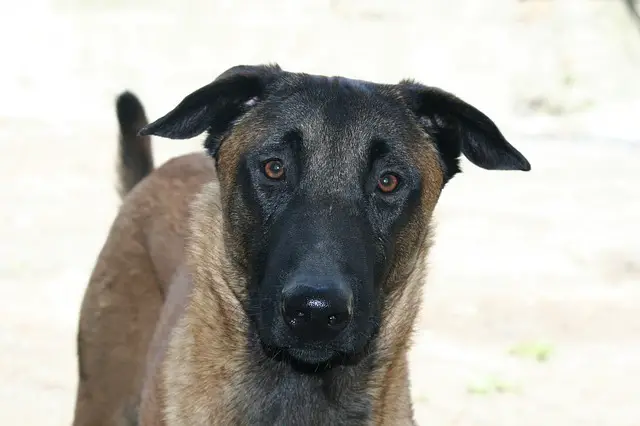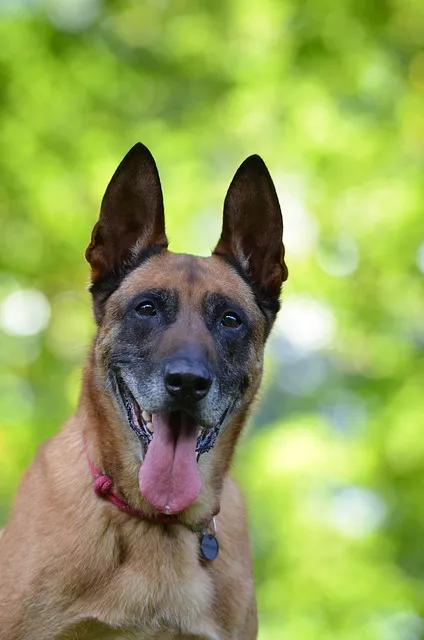Canines have stellar noses for smelling and some dogs can smell up to 1,000,000 times better than a human depending on the breed.
Their eyes however are very different from the human eye. Most dogs and including the Belgian Malinois, do not have 20/20 vision. Some have only about 20/75 vision.
This means that a human 75 feet away from an object can see it from that distance but a dog has to be 20 feet away to see that same object clearly.
On the other hand, dogs do have better peripheral vision than human beings because their eyes are more to the side of their heads and they also can pick movements up more quickly.
Contrary to popular belief, canines do not just see in black and white, they see in limited color just as those that are color blind do.
Dogs cannot distinguish colors that are red, orange, or green. Belgian Malinois and other breeds rely on their sense of smell, positioning of objects, and textures, and use brightness to distinguish but even with 20/75 vision they really don’t miss a trick!
Eyesight is very important to your Belgian Malinois and that’s why you should be aware of Belgian Malinois eye problems.
One of the biggest health issues of the Belgian Malinois is eye conditions with most occurring in older adult dogs.
This post will contain information on eye problems as well as Belgian Malinois eye infection symptoms and Belgian Malinois eye discharge.

For your dog’s vitamin supplement, food, toys, or other dogs product please visit the Sundays for dogs website.
Belgian Malinois Eye Problems
The Belgian Malinois is a hard-working dog, originally bred for herding sheep in the quaint countryside of Belgium.
They are a very protective breed, often working with the police and military, but trained properly, they make excellent loyal, and loving family dogs.
The Belgian Malinois is basically a strong and healthy breed but can be prone to a few health problems and some are eye and vision-related. The following are eye problems that Belgian Malinois can suffer from.
Progressive Retinal Atrophy
Progressive Retinal Atrophy (PRA) is an eye disease that is genetic and hereditary in nature. The Belgian Malinois, unfortunately, is more prone than some breeds to develop PRA.
This is why it’s so important to get your Belgian Malinois from a reputable breeder and one that has their breeding dogs genetically tested.
Dogs carrying PRA should not be bred and neither should their brothers or sisters regardless of the fact that none may have symptoms or exhibit signs of PRA.
PRA occurs when photoreceptor cells in the eye deteriorate or waste away as in the meaning of atrophy.
The job of the photoreceptor cells is to send signals to the brain when light enters the eye and is focused on the retina.
In the back of the retina are the photoreceptors and without them, blindness gradually occurs.
There are two different configurations of PRA, one that develops in dogs as adults from three to nine years of age and another in puppies two to three months old. In puppies, it is called retinal dysplasia.
Symptoms of progressive retinal atrophy are dilated pupils and increasing night blindness.
Because dogs have pretty keen eyesight in the dark, this would be evident by them bumping into furniture, etc. at night.
Loss of sight will also be recognized when your pup is in unfamiliar places. PRA affects both eyes with vision worsening gradually until the result is total blindness. This may take one to two years.
There is no cure for PRA and it is not painful. Dogs usually acclimate much quicker than humans to sightlessness because they use their senses of smell and hearing better and are much more attuned to those senses.
Pannus
Pannus is another eye disease related to genetics and is sometimes referred to as superficial keratitis.
Pannus is an autoimmune disease that affects your Belgian Malinois cornea causing scarring, and impaired vision, and can lead to blindness.
Both eyes are generally affected. Since the cause of autoimmune diseases is somewhat of a mystery, there are really no preventative measures for pannus, except being aware of the signs and making sure your Belgian Malinois has regular veterinary visits including eye exams.
Pannus causes cloudiness and pigmentation changes usually beginning from the outside of the cornea and moving in.
Blood vessels become prominent. Some studies show food allergies, exposure to UV light, or living at a higher altitude can play a role in the development of pannus.
Treatment for pannus includes anti-inflammatory or steroidal eye drops or oral medication and sometimes a change in diet to an anti-inflammatory lessening diet which can help pannus from progressing.
To check your Belgian Malinois health status or their DNA, please visit the Embark vet website for all the help you may need.

Persistent Pupillary Membrane
This eye condition is considered a birth defect and is hereditary. Dogs that carry this predisposition should not be bred.
With this problem, a strand or strands of the membrane that should have dissolved at birth, attach to the iris.
Depending on where strands are, it can range from serious vision impairment to a minimal impact on vision.
When strands are from the iris to the lens, vision problems can be minor. Strands from the iris to the cornea can cause complete blindness and are by far the more serious type. Surgery is possible if cataracts develop.
In more severe cases blindness may occur but often, these strands will resolve themselves often by dissolving, without impeding vision.
Cataracts
Cataracts are quite common in geriatric dogs and this is no exception in the Belgian Malinois.
Cataracts cause cloudiness to the lens of the eye and can cause eventual blindness. Drops can be used to slow progression and surgery is an option for restoration of sight.
Belgian Malinois Eye Discharge and Eye Infections
Everyone, including dogs, does have some type of eye discharge and most times it’s perfectly normal. Sometimes, however, it is a cause for alarm. Below are different types of discharge and what they may mean.
What is Normal?
Whenever humans and dogs alike sleep, their eyes are still producing tears to keep the eye moist.
When your Belgian Malinois wakes in the morning, it may have some crusty gunk in the corners of their eyes. This is absolutely normal. Simply wipe with a soft cloth.
White or Grey Discharge
This can be a sign of dry eye. Yes; dogs can have dry eyes too. Their immune system destroys the tear-producing glands and to make up for the loss of lubrication the eye produces mucus, which does not do an adequate job of lubricating the eye.
In Belgian Malinois, the dry eye needs to be treated with eye drops to prevent painful red eyes that could lead to injury to the eye and possible complications and infection.
Yellow or Green Discharge
Yellow or green discharge in your Belgian Malinois eyes can be a cause for concern. This usually signals an eye infection like conjunctivitis also called pink eye which is quite common in dogs.
Your pup’s mucous membranes and membranes under the eyelid become inflamed and red and emit a yellow or green discharge.
Conjunctivitis can be caused by environmental allergies, a foreign object in the eye, bacteria, or a virus. It may affect one eye or spread to both.
Treatment for pink eye is generally antibiotic eye drops and in some cases oral antibiotics too.
Eyewash may also be prescribed and wiping the eyes with a soft cloth or eye wipes to remove discharge is also recommended.
Your Belgian Malinois can also suffer from a corneal ulcer from a scratch which can, in turn, lead to a corneal infection with more icky discharge.
Treatment should begin from the first signs with antibiotic ointment or drops. Corneal ulcers can lead to vision loss if not treated swiftly.
Your Belgian Malinois may never have any eye issues or conditions, but be aware of their eyes. Even though your pup has other senses, their eyesight is very important.
If you notice anything unusual or out of the ordinary, see your veterinarian promptly. Even a minor eye condition can escalate into something much more serious if left untreated.